The Dell XPS 13 (9300) Review: Return of the King
by Brett Howse on July 16, 2020 10:00 AM ESTGPU Performance
One area where Intel-based notebooks had previously was in the graphics department, and with Intel’s launch of Ice Lake they directly addressed that. Along the way, Intel has also joined AMD in more aggressively demarcating their integrated GPUs based on the price of the processor. Intel always had a small bit of variation in the included GPU, but for the most part, a Core i3, i5, or i7 U-series would generally offer the same 24 Execution Unit GPU configuration. With Ice Lake, the naming scheme now includes the GPU size in the processor name, with G1, G4, and G7 graphics options, meaning lower-priced Core i3 and i5 models will not necessarily be outfitted with the same iGPU as a Core i7.
| Intel 10nm Ice Lake-U Series CPUs | |||||||||
| AnandTech | Cores Threads |
Base Freq |
1C Turbo |
AC Turbo |
GPU EUs |
GPU Freq |
L3 Cache |
TDP | |
| Core i7-1068G7 | 4 Cores 8 Threads |
2.3 | 4.1 | 3.6 | 64 | 1100 | 8 MB | 28 W | |
| Core i7-1065G7 | 4 Cores 8 Threads |
1.3 | 3.9 | 3.5 | 64 | 1100 | 8 MB | 15 W 25 W |
|
| Core i5-1035G7 | 4 Cores 8 Threads |
1.2 | 3.7 | 3.3 | 64 | 1050 | 6 MB | 15 W 25 W |
|
| Core i5-1035G4 | 4 Cores 8 Threads |
1.1 | 3.7 | 3.3 | 48 | 1050 | 6 MB | 15 W 25 W |
|
| Core i5-1035G1 | 4 Cores 8 Threads |
1.0 | 3.6 | 3.3 | 32 | 1050 | 6 MB | 15 W 25 W |
|
| Core i3-1005G1 | 2 Cores 4 Threads |
1.2 | 3.4 | 3.4 | 32 | 900 | 4 MB | 15 W 25 W |
|
This comes into play since Dell offers three processor options on the XPS 13, with both the Core i3 and Core i5 variants only offering the G1 graphics. To be clear, even the G1 Generation 11 graphics on Ice Lake are a larger GPU than the previous Gen 9.5 offered, with even the lowliest Core i3 featuring 32 Execution Units, but the full GPU in this laptop is only found if you choose the Core i7 model, which offers the 64 Execution Unit G7 graphics. It makes choosing the processor a bit more complex than it used to be, as it would be on an AMD-based laptop which follows the same mantra.
Dell shipped the XPS 13 review unit with the Core i7-1065G7, and as such this device does feature the full-sized GPU, and as we have seen in other Ice Lake based notebooks, the larger GPU is a significant improvement over previous designs.
3DMark
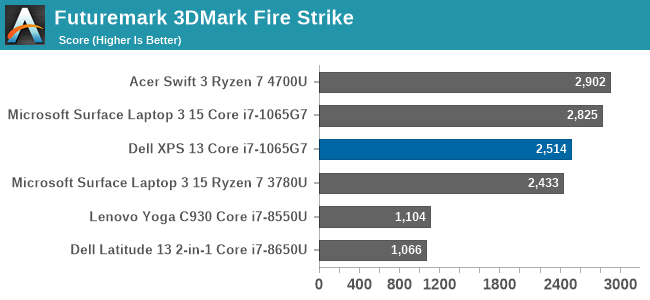
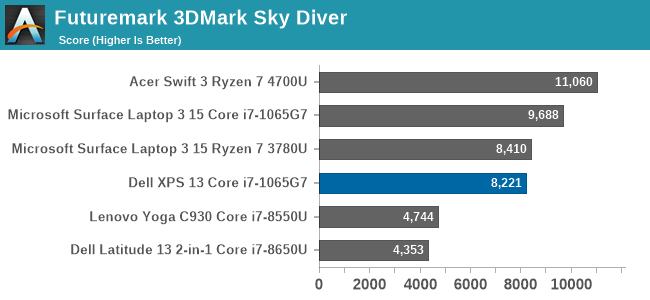

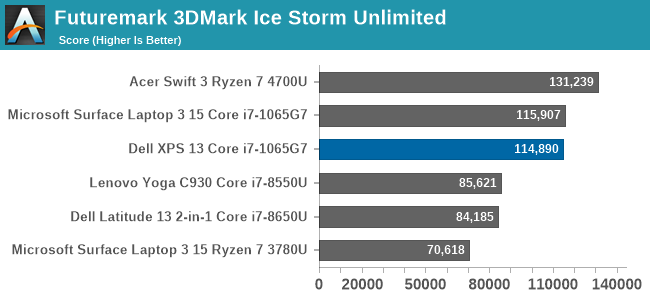
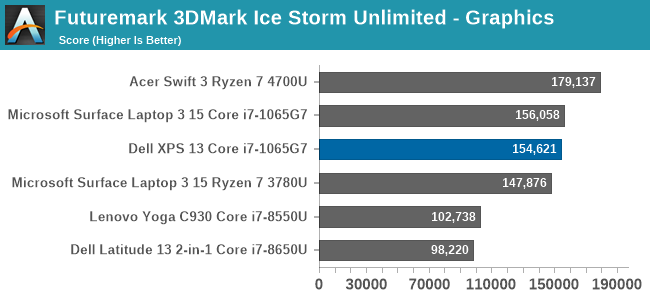
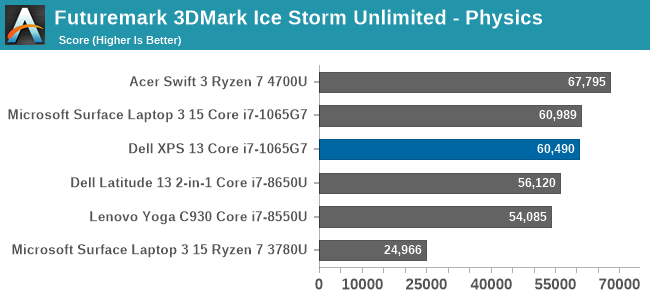
In our first synthetic test, the XPS 13 finishes slightly behind other Ice Lake notebooks, but not by a wide margin.
GFXBench
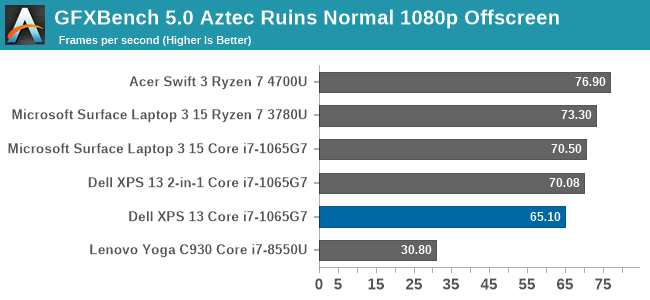

We run the DirectX 12 tests from version 5 of GFXBench, and as expected, the XPS 13 scores right in the same range as expected.
Tomb Raider
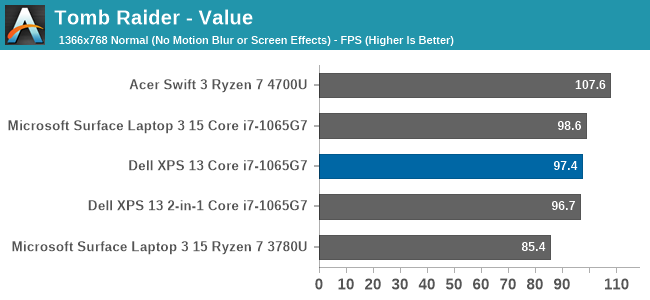
The original Tomb Raider has been a challenge on integrated GPUs, but with AMD’s Ryzen and Intel’s Ice Lake, the game is finally playable although without any extreme graphics settings enabled. Once again, the XPS 13 slots in right where it is expected.
Rise of the Tomb Raider
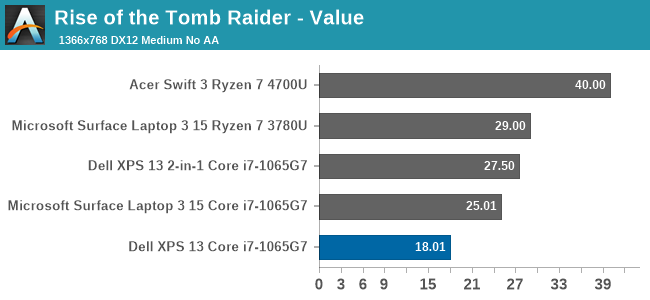
The first sequel to the re-launched Tomb Raider series is much more graphically demanding, and the XPS 13 slides out of the playability window even at the lowest settings we test at.
Strange Brigade
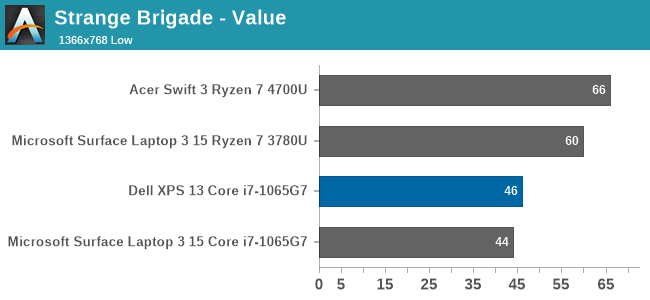
Strange Brigade is a game with a wide-range of settings, and can be very playable even on integrated graphics. As seen with Rise of the Tomb Raider though, the XPS 13 is not quite as performant as some of the other Ice Lake notebooks we have tested.
F1 2019
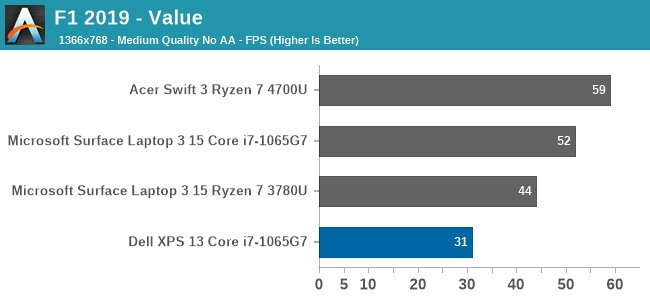
Codemaster’s F1 simulator did not fare very well on the XPS 13, scoring well under expectations. This game can be very CPU limited as well, so TDP can be a major factor.
Far Cry 5

Like most of the other games, we see that Far Cry 5 is once again below other Ice Lake systems, but even on the best integrated system Far Cry is only barely playable regardless.
GPU Conclusion
Although the XPS 13 was outfitted with the top of the range Core i7-1065G7, with its full 64 Execution Unit GPU, the XPS 13 was not quite able to match some of the other Ice Lake systems we have seen. We will get into that a bit more in the thermals section, but this is likely due to Dell more aggressively clamping the processor to its recommended 15-Watt TDP, where other manufacturers may be more aggressive and allow 20+ Watts. Since the GPU is one area where more thermal headroom is always welcomed, this can have a larger impact than a CPU-bound task.
Otherwise, while the Ice Lake G7 GPU configuration is nothing short of a massive step up from Intel's earlier integrated GPUs, they are also competing with AMD in a field that's normally AMD's strength. So for as fast as the G7 configuration is, it and the XPS 13 end up trailing laptops based on the half-a-generation newer AMD Ryzen 4000 APUs.










224 Comments
View All Comments
TheinsanegamerN - Thursday, July 16, 2020 - link
If tiger late is as impressive as ice lake the ryzen 4700u will retain a significant advantage in performance, and I'll believe it releases when I see it.Deicidium369 - Thursday, July 16, 2020 - link
Much more impressive. 4C Tiger Lake is 17% slower than 8C Renoir - and Xe LP is at least 2x as fast as Gen11 (in Ice Lake) and performs as well as a Nvidia MX350 (hence why Nvidia is pushing out the Turing MX450) - which wrecks the ancient Vega.So double the cores and a whopping 17% perf advantage - and much slower iGPU - are we sure that AMD understands the laptop market?
rhysiam - Thursday, July 16, 2020 - link
You are doing some gold-standard cherry picking here. Which chart gets you this "17% slower" number you keep quoting as if it's gospel? The 15W thermal envelope is the limiting factor here, so "double the cores" won't net you anywhere near double the performance, nor are they supposed to.According to this very review, lightly threaded tests show the 4700U on par with the similarly clocked Ice Lake. They are neck and neck. IPC is very close between Zen 2 and Sunny Cove.
Highly threaded workloads are dominated by AMD:
CB: 4700U is 52% faster
HB(software): 4700U is 71% faster
HB(hardware): 4700U is 79% faster
7-Zip(comp): 4700U is 34% faster
7-Zip(decomp): 4700U is 40% faster
Remember that the 4700U is **not** the top SKU (though admittedly the 4800U isn't much faster).
Again - where is this "17%" coming from if not deceptively cherry picked?
Tiger Lake looks to have a massive GPU, but what are we looking at CPU wise? A few % IPC and very small clock bump? Maybe Intel squeeze out a tiny single threaded lead, while still getting trashed in multi-core workloads - in exchange for a better iGPU.
Spunjji - Friday, July 17, 2020 - link
@rhysiam - He's basing his claims on an early benchmark leak that does indeed suggest a healthy single-thread lead for Tiger Lake and a moderate multi-core deficit. It doesn't look to be a particularly unreliable leak - apparently comparing like-for-like in terms of chassis - but it's still just the one leak. There are also leaks implying a far less dramatic advantage for the Xe LP GPU, but he's not citing those.When it comes to Deicidium, information suggesting Intel superiority is taken as gospel and information suggesting otherwise is discarded. He spent the months leading up to Renoir's release refusing to believe any of the benchmark leaks favouring AMD and hammering on how unreleased products don't matter. Go figure.
Deicidium369 - Friday, July 17, 2020 - link
Yeah, boy as I wrong - that Great Renoir can compete with an almost year old design! That is unbelievable. With such massive year over year IPC increases - would only be fair to compare the Great Renoir with Alder or Meteor Lake.Too bad AMD marketing never pans out and when the fanboys get it - and filter it through their fever dreams - it is even more disappointing when released - The Another Marketing Deception product release
HYPE HYPE HYPE LAUNCH SIGH! NEXT (or compare to last years outgoing CPU)
Korguz - Friday, July 17, 2020 - link
just like you do as well Deicidium369. so look who's talking, little childByte - Friday, July 17, 2020 - link
I guess competitive means you are still alive in a two horse race. Doesn't matter if your horse overheated on the side of the road.Santoval - Friday, July 17, 2020 - link
If Tiger Lake is still capped at 4 cores (and apparently both the Y and U variants are, though the -H variant will probably have up to 6 cores) it will not be able to compete with AMD's APUs in *CPU* performance. According to some leaks though Tiger Lake's Xe iGPU outperforms the (very) old Vega based iGPU that for some inexplicable reason (to avoid internal competition with their lowest end Navi graphics cards?) AMD decided to add to their 4000 APU series.Well, Xe hasn't even been released yet and Vega was released 3 full years ago, so if Xe couldn't even outclass (barely apparently) a 3-year old iGPU Intel would be in deep trouble. Tiger Lake might outperform AMD's APUs in single thread performance, but that doesn't matter as much anymore. The question is how much Intel managed to raise the IPC and the clocks of Tiger Lake over Ice Lake, but it's not "doubtful" at all that AMD's APUs will be in most ultrabooks by early next year. Only people who were sleeping in a technological cave for the last 3 years would think that.
Deicidium369 - Friday, July 17, 2020 - link
inclusion of Vega was AMD's choice.Ice Lake had a 30% increase in IPC (the quip about, at the expense of lower clocks is meaningless) and with improved 10nm+ and architectural advanced in Willow Cove equate to an actual IPC increase, not just one in marketing materials.
4 cores can easily equal AMD 8 cores. These are ultralights - they are not DTR - 4 superior cores + superior graphics are the best mix - not 8 cores an ancient Vega iGPU.
They won't be in premium devices - it is not their market - Lenovo is as close as they will come - not worth the OEMs to design around a niche APU that won't sell in profitable numbers.
OEMs seem to not want to make the investment into AMD designs, no one is asking for them, and they have no advantage over the well established, steady (Intel never dropped out of sight for more than a decade) and reliable Intel.
MOAR COARZ. LMAO.
Korguz - Friday, July 17, 2020 - link
lets see you post proof of this, Deicidium369. if not, its just your usual pro intel, anti amd bs, as you always post.